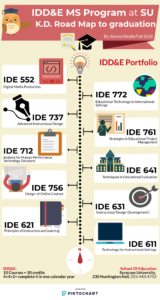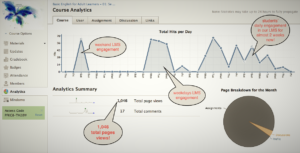Instructional Design, Development, and Evaluation (IDD&E) Master of Science Program at Syracuse University
Roadmap to Graduation

MS IDD&E program at Syracuse University count with a total of ten courses for a total of 30 credit/hours. They are usually taken in a set format of 4 courses in the Fall, four courses in the Spring, and 2 Capstone courses in the Summer. Successful completion for each of the required courses and a final digital Portfolio review lead to the completion of the program at the
end of the Summer.
Thanks to the flexibility and support of the program Professors and Chair, I was able to re-organize my program of studies as follows: three courses in the Fall, one Winterlude course, three Spring courses, two Capstone courses in the Summer and one final course on the next Fall toward Winter graduation. This model, helped me to focus on learning the materials offered in class, apply concepts while working in individual and group projects, and share results with other classmates in presentations.
This section includes all the courses taken, a summary of each goal and learning objectives, and examples of selected projects.
FALL’17 | WINTERLUDE | SPRING | SUMMER | FALL’18
FALL’17 COURSES
IDE 611: Technology for Instructional Settings/ Final Grade: A
IDE 621: Principles of Instruction and Learning/Final Grade: A
